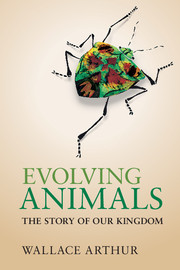Book contents
- Frontmatter
- Dedication
- Contents
- Preface
- Acknowledgements
- 1 What is an animal?
- 2 Before there were animals
- 3 How to make a fossil
- 4 The Cambrian explosion
- 5 How to make a species
- 6 Jellyfish and their kin
- 7 How to make a tree
- 8 The enigmatic urbilaterian
- 9 Animal symmetry and heads
- 10 A plethora of worms
- 11 Trends in animal complexity
- 12 Where the octopus is king
- 13 How to make an animal
- 14 Exoskeletons galore
- 15 Extinction
- 16 Mouth first, mouth second
- 17 Comparing embryos
- 18 Larvae, mouthparts and moulting
- 19 The animal toolkit
- 20 Vertebrate origins and evolution
- 21 From water to land to water
- 22 Variation and inheritance
- 23 Evolutionary novelties
- 24 Human origins and evolution
- 25 Animal plasticity
- 26 The nature of adaptation
- 27 The direction of evolution
- 28 Animal extremophiles
- 29 Extraterrestrial animals?
- 30 The ghost in the machine
- Appendix
- References
- Index
5 - How to make a species
Published online by Cambridge University Press: 05 August 2014
- Frontmatter
- Dedication
- Contents
- Preface
- Acknowledgements
- 1 What is an animal?
- 2 Before there were animals
- 3 How to make a fossil
- 4 The Cambrian explosion
- 5 How to make a species
- 6 Jellyfish and their kin
- 7 How to make a tree
- 8 The enigmatic urbilaterian
- 9 Animal symmetry and heads
- 10 A plethora of worms
- 11 Trends in animal complexity
- 12 Where the octopus is king
- 13 How to make an animal
- 14 Exoskeletons galore
- 15 Extinction
- 16 Mouth first, mouth second
- 17 Comparing embryos
- 18 Larvae, mouthparts and moulting
- 19 The animal toolkit
- 20 Vertebrate origins and evolution
- 21 From water to land to water
- 22 Variation and inheritance
- 23 Evolutionary novelties
- 24 Human origins and evolution
- 25 Animal plasticity
- 26 The nature of adaptation
- 27 The direction of evolution
- 28 Animal extremophiles
- 29 Extraterrestrial animals?
- 30 The ghost in the machine
- Appendix
- References
- Index
Summary
Charles Darwin’s On the Origin of Species, published in 1859, can rightly be regarded as the start of evolutionary biology. That’s not to say that it was the first publication on evolution, but it was the first to convince most scientists – in some cases immediately and in others eventually – that (a) evolution had happened and (b) it occurred via a particular mechanism, namely natural selection, or ‘survival of the fittest’.
In the previous chapter we saw that, whatever uncertainties remain about the origin of animals, by 500 million years ago the Cambrian oceans were teeming with animal life. They were doubtless teeming with bacterial and algal life too, though the flowering plants that dominate the plant kingdom today did not evolve until much later. In the Cambrian, all multicellular life-forms were aquatic – the land did not get colonized by plants and animals for probably another 100 million years.
Because natural selection is a general mechanism of evolutionary change, it must have been operating in those ancient marine ecosystems of the Cambrian much as it operated in their more recent terrestrial equivalents over the last six or seven million years to modify human and chimp lineages from their last common ancestor. And indeed it is still operating in the same way today, as we see in the evolution of biocide-resistant insects and bacteria.
- Type
- Chapter
- Information
- Evolving AnimalsThe Story of our Kingdom, pp. 45 - 55Publisher: Cambridge University PressPrint publication year: 2014



